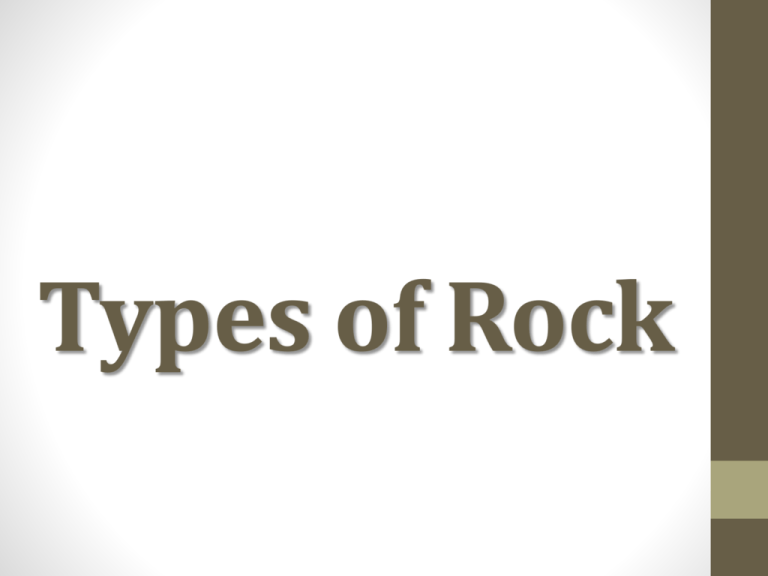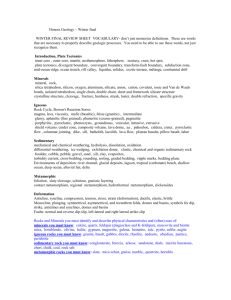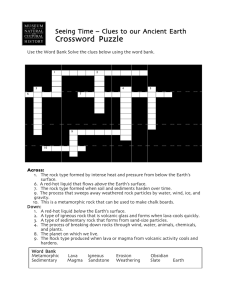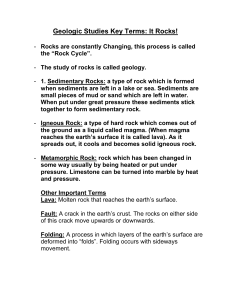Bell work
advertisement

Types of Rock Igneous Rock How does it form? Rock that has formed from the cooling and solidification of magma or lava. Igneous Rock Two Kinds of Igneous Rock: • Intrusive: Form from slowly cooling magma within the Earth’s surface. • Large Crystals • Rough Texture • Extrusive: Form from quickly cooling lava on the Earth’s surface • Small Crystals • Fine Texture Igneous Rock Sedimentary Rock • Rock formed from the compaction and cementation of sediments or from the precipitation of minerals in a solution. • Compaction – squeezing together • Cementation – gluing, sticking together What is sediment? • Sediments are fragments of rock that have been broken down as a result of weathering (wind, ice, running water, etc.) Sedimentary Rock • Sediments are classified according to their size. Clay Silt Sand Pebble Cobble Boulder Clastic Sedimentary Rock • The word clastic comes from Greek work, meaning “broken” • Formed from particles of rock (clay, silt, sand that have been compacted together. Clastic Sedimentary Rock • Shale formed from fine sediments, (i.e., clay or silt). Clastic Sedimentary Rock • Sandstone formed from medium-size sediments, (i.e., sand). Clastic Sedimentary Rock • Conglomerates formed from large pebble-size sediments. Nonclastic Sedimentary Rock • Formed by chemical precipitation or by organic activity • Salt rock formed by evaporation • Limestone formed by chemical precipitation or organic activity Nonclastic Sedimentary Rock • Limestone Fossils • Sedimentary rocks are the only type of rocks that may contain fossils, or evidence of past life. Metamorphic Rock • Rock formed from a change that has occurred as a result of exposure to intense heat and/or pressure. Metamorphic Rock •Two types of metamorphism 1. Contact metamorphism 2. Regional metamorphism Contact metamorphism • Involves existing rocks coming into contact with really intense heat (i.e., lava / magma). Regional Metamorphism • Involves existing rocks experiencing extreme pressure as a result of being pushed together by two converging plates. Regional Metamorphism Types of Rock Brochure Project • Your brochure must include the following pages: • Title Page (e.g., Three Types of Rock) with Name • Contents Page (How the rocks form) • Provide a definition for each type of rock. • Rock Type #1: Igneous Rock • Rock Type #2: Sedimentary Rock • Rock Type #3: Metamorphic Rock • Provide a title for each page of the rock type. • Each page should include information that is specific to that type of rock. Igneous Rock • Two Kinds of Igneous Rock: • Intrusive: Form from slowly cooling magma within the Earth’s surface. • Large Crystals • Rough Texture • Extrusive: Form from quickly cooling lava on the Earth’s surface • Small Crystals • Fine Texture Sedimentary Rock • Two Kinds of Sedimentary Rock: • Clastic: Form from particles of rock (e.g., clay, silt, and sand) • Compacted Sediments • Nonclastic: Form from chemical precipitation or by organic materials. Metamorphic Rock Two Types of Metamorphism: • Contact Metamorphism: Involves existing rocks coming into contact with really intense heat (i.e., lava / magma). • Regional Metamorphism: Involves existing rocks experiencing extreme pressure as a result of being pushed together by two converging plates.






